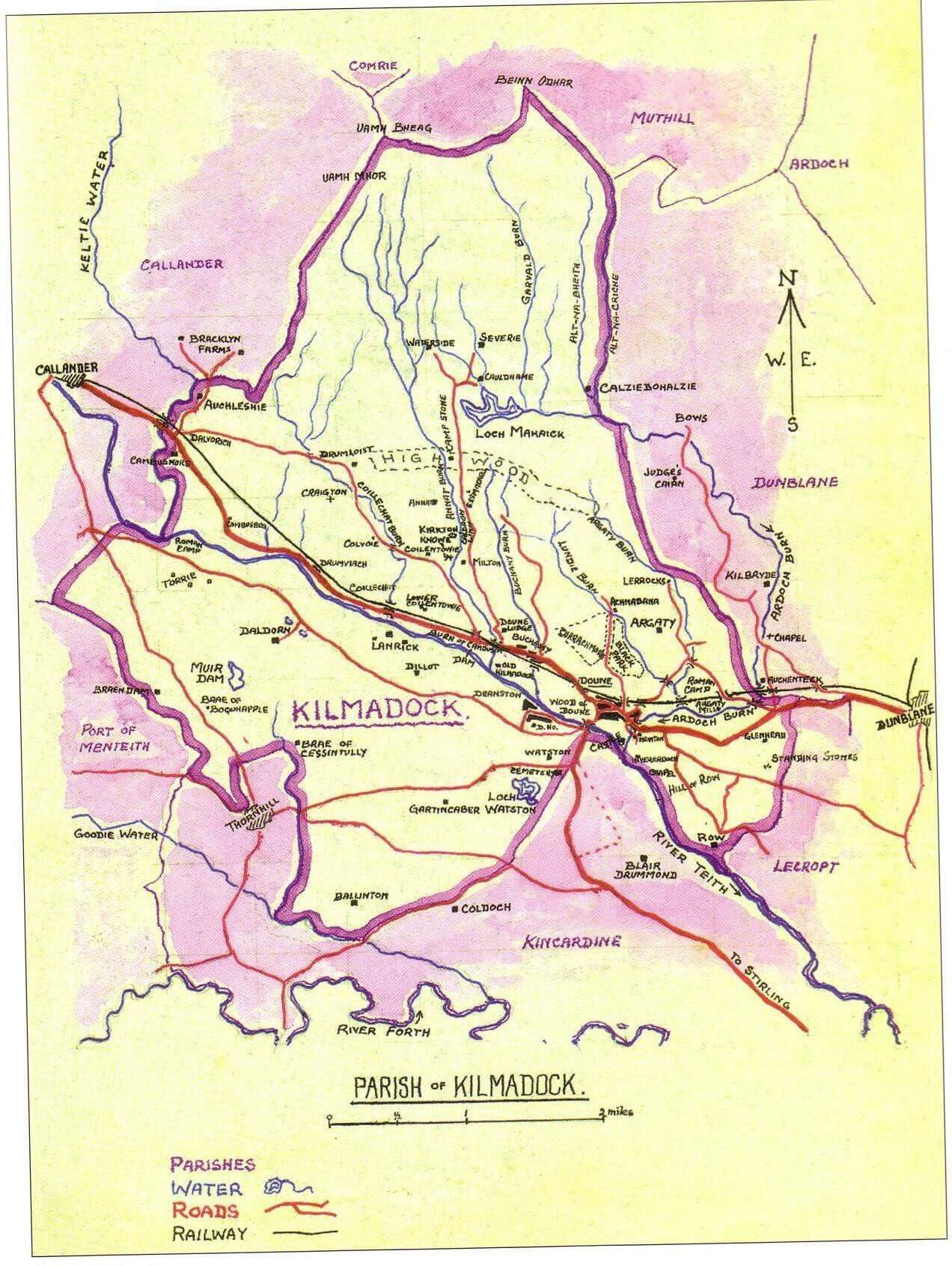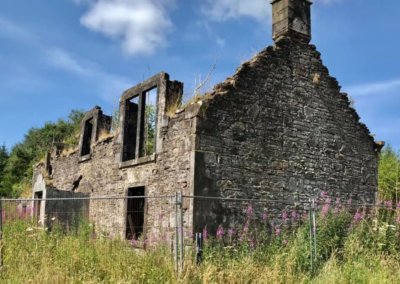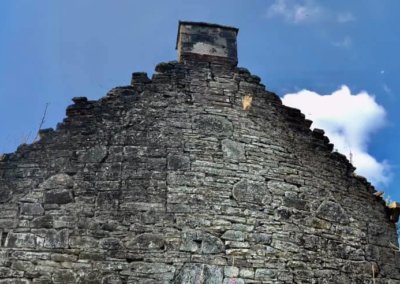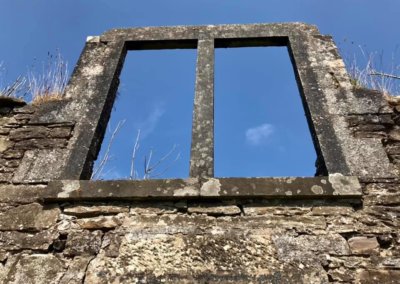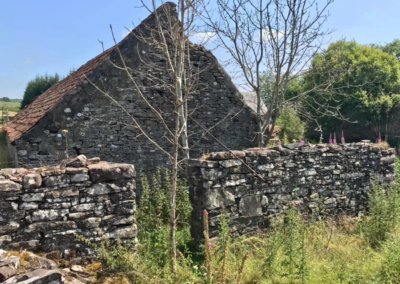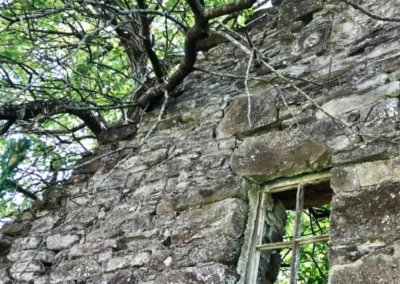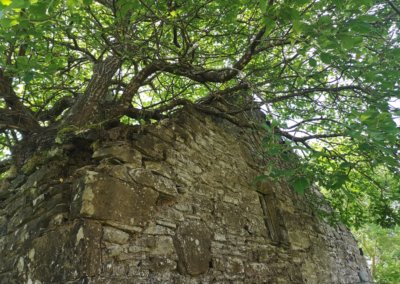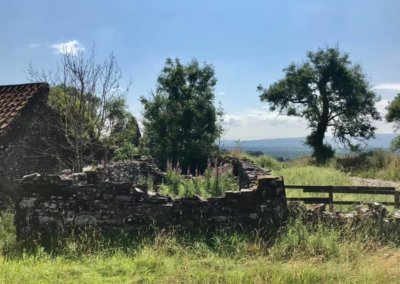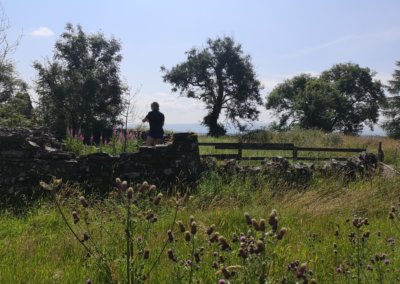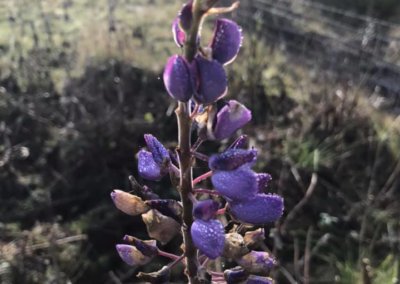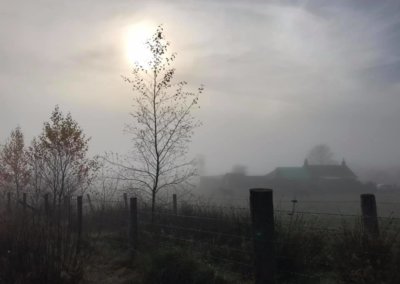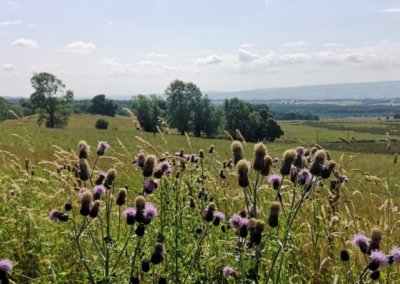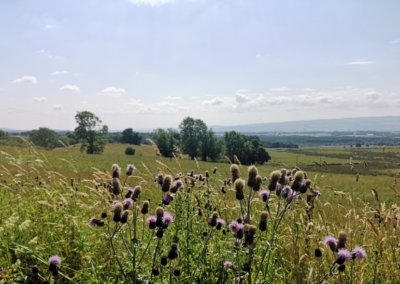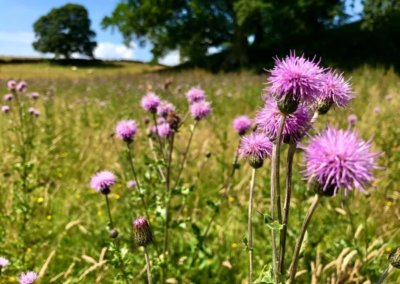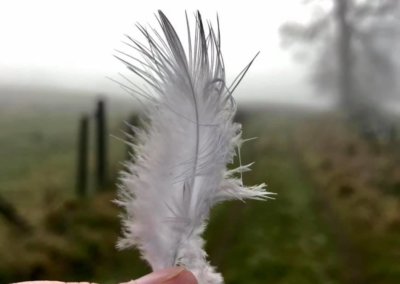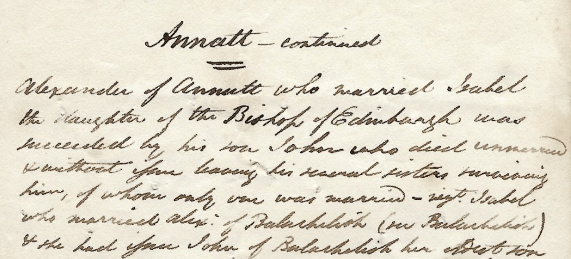The Stewarts of Annat, Kilmadock, Perthshire, Scotland
The Fourth Major Branch of the Stewarts of Balquhidder
The Stewarts of Annat lived at Annat in the parish of Kilmadock in Perthshire, Scotland. (Modern spelling: Annet.) Their original residence was a small castle by the Annat (Annet) burn, and later a manor house, both now in ruins.
The Stewarts of Annat were deeply involved in the Jacobite Risings of 1715 and 1745. Notorious Jacobites Allan Breck Stewart and James Stewart of the Glen both stayed at Annat House on route to the infamous Appin Murder Trial that led to the wrongful conviction and execution of James of the Glen.
The Origins of the Stewarts of Annat
The Stewarts of Annat were the youngest of the four principal families descended from the ancient Stewarts of Baldorran and Balquhidder, including the families of the Stewarts of Ardvorlich, the Stewarts of Glenbuckie, and the Stewarts of Gartnafuaran. Alexander Stewart, 1st Laird of Annat (below), was a nephew to Alexander Stewart, 1st of Ardvorlich, by Ardvorlich’s younger brother, John Stewart, 1st of Portnellan (below). Alexander Stewart, 1st of Annat, purchased the lands of Annat in Kilmadock Parish in 1621 from James Muschet of Burnbank. The Annat lands were later sold to their cousins, the Stewarts of Ballachallan, also in Kilmadock Parish, and by the early 19th century this estate had been completely broken up among some of the larger neighbouring estates. By 1820 the principle line of the Stewarts of Annat became extinct, although their cousins, the Stewarts of Rait, were styling themselves as “of Annat” at that time.
Sources
In our research, we cite many documentary sources. Some of the most common ones that you will find referenced and abbreviated in our notes include:
- Duncan Stewart (1739). A Short Historical and Genealogical Account of the Surname Stewart…. (It’s actual title is much longer), by Rev. Duncan Stewart, M.A., 1st of Strathgarry and Innerhadden, son of Donald Stewart, 5th of Invernahyle, published in 1739. Public domain.
- Stewarts of the South. A large collection of letters written circa 1818-1820 by Capt. James Stewart, factor (estate manager) to Maj. Gen. David Stewart of Garth, comprising a near complete inventory of all Stewart families living in southern Perthshire, including all branches of the Stewarts of Balquhidder.
- MacGregor, Gordon, The Red Book of Scotland. 2020 (http://redbookofscotland.co.uk/, used with permission). Gordon MacGregor is one of Scotland’s premier professional family history researchers who has conducted commissioned research on behalf of the Lord Lyon Court. He has produced a nine volume encyclopedic collection of the genealogies of all of Scotland’s landed families with meticulous primary source references. Gordon has worked privately with our research team for over 20 years.
- The Stewarts of Ardvorlich, Books 1-3, and Supplement. Privately published. The originals are housed at the Stewart Society Archives in Edinburgh, Scotland. Digitized by the Stewarts of Balquhidder Research Group in 2023 with permission from Sandy Stewart, 15th of Ardvorlich (26 June 2023). Copyright of these books remains with the family of the Stewarts of Ardvorlich with permission granted only to the Stewart Society and the Stewarts of Balquhidder Research Group to publish the full digital versions on their respective websites. The digital versions may not be reproduced, republished, or reposted on any other websites without permission from the family of the Stewarts of Ardvorlich.
- The Stewarts of Ardvorlich Vol. 1, ©1946 by John Stewart of Ardvorlich, Ardvorlich, Perthshire, Scotland, self-published, bound by L. Dopierala, Perth, Perthshire, Scotland.
- The Stewarts of Ardvorlich Vol. 2, ©1968 by John Stewart of Ardvorlich, Ardvorlich, Perthshire, Scotland, self-published, bound by L. Dopierala, Perth, Perthshire, Scotland.
- The Stewarts of Ardvorlich Vol. 3, ©1975 by John Stewart of Ardvorlich, Ardvorlich, Perthshire, Scotland, self-published, bound by L. Dopierala, Perth, Perthshire, Scotland.
- The Stewarts of Ardvorlich – Supplement, ©1985 by John Stewart of Ardvorlich, Ardvorlich, Perthshire, Scotland, self-published.
- [Parish Name] OPR. This refers to various Old Parish Registers.
- For a full list of sources, click here.
Annat
Annat is located in Kilmadock Parish just a few miles northwest of the village of Doune. It is shown on modern Ordnance Survey maps as “Annet.” The name derives from the Gaelic word annaid which is one of several ancient Gaelic words for “church.” Archaeological evidence indicates that the original location for St. Cadoc’s church was near the current location of the ruins of Annat House. The nearby locations of Kirkton Knowe (“hill of the church town”) and Aiglesteinston (possibly eccles Iestyn, “church of St. Iestyn” or “church of the little saint”) support its ecclesiastical origins. (See McNiven, below, for more information.)
Annat Ruins (Google Maps – Note: If you search for “Annet Burn” on Google Maps it will give you the wrong location.)
Kilmadock Parish
Kilmadock parish has at times also been known as Doune parish. The parish seat for Kilmadock is the nearby village of Doune. Unlike many of the neighbouring parishes (Callander, Balquhidder, Aberfoyle, Comrie, etc.), Kilmadock does not derive it’s name from the name of the parish seat town, but rather draws its name from the name of the nonextant monastery dedicated to the ancient Celtic Saint Cadoc. Like many other Gaelic place names the original name has become contracted and altered from its original form which was likely Cille mac Ghille Cadoc (literally “monastic cell of the son of the servant of Saint Cadoc”.) (ROOK)
Mackay's History of Annat
The following information and map are from Doune Historical Notes by Moray S. Mackay, (c)1954, reprinted 2003, Jamieson & Munro.
The more orthodox etymology for the name of the farm, Annat, approved by Professor Watson, gives this as the oldest church term in Gaelic, and says that the name means “the parent church” or “the patron saint’s church”- one dedicated to him or at whose dedication he was present. In modern Gaelic the word is annaid. Annats, or “patron saint’s churches” are frequently found close to water. In the case of the Annat farm of the Stewarts of Annat: locally the name Annat is that of a burn which lies wholly within the parish of Kilmadock, flowing south by southeast from the highest braes on the southern slopes of Uam Var (Uamh Mhor) to it’s junction with the River Teith at Old Kilmadock (the site of the monastery), about 1-1/4 miles from Doune. There are several waterfalls in it’s course from the high wood to the Burn of Cambus. About a third of a mile north of Milton Farm, one of the pools is called the “Caldron Linn”, (probably from coire nan linn in Gaelic, meaning “glen of the pool”). Annat Farm is less than half a mile upstream from this place, on the west side of the burn.
Lower down, nearly opposite Milton, there is a steep-sided knoll, on the high west bank of the burn, called the Kirktown Knowe, which is the site of the ancient chapel and graveyard from which the orthodox derivation of the name Annat is here taken. This was one of the seven local chapels which came under the jurisdiction of the Old Kilmadock monastery. About a hundred yards west of the Caldron Linn is the site of the ancient castle of Annat about which little is known and the only remaining sign of which is to be seen during a hot dry summer when the grass gets burned a little, and the plan of the walls may be faintly traced. There is little, if any, trace of the chapel or graveyard now apart from one or two stones on top of the knoll, but the immediate vicinity shows broad signs of previous human activity in the strange configuration of the ground.
Another highly plausible etymology of the name Annat suggests that the name derives from Annait, which is the name of an ancient Goddess of Victory in the pantheon of the Caledonian Gaels. Mackay suggests that Annat was the location of an ancient battle between the Caledonian Gaels and perhaps an invader from Northumbria, at which the Caledonians were victorious. In honour of their victory they might well have named the site of the battle after the goddess whom they believed gave them victory. Excavations in the area give support to the theory that an ancient (Roman) military camp once existed in the area. Mackay also notes that such a battle is known to have occurred just east of Annat where present-day Rosehall Farm is located.
ROOK History of Annat
Prepared by Peter Herbert, resident of Doune, Scotland, and the members of the Rescuers of Old Kilmadock, for the occasion of the Moody-Stuart Family Reunion, 20 April 2019.
The lands of Annat were probably originally given to the mother-house of Kilmadock for the support of the clergy there – one meaning of Annat being “first benefice of the Church”. It is strongly believed that the original ancient Parochial Church and graveyard was located on Annat, although nothing can now be seen. In 1560 Scotland broke with Rome and declared itself Protestant, which led a revision of the church land holdings.
1649 Land Tax shows John Stewart of Annat paying ‘one four score punds’, £180, for Annatt and Nether Callantowie. The holding, in 1649, would not be a farm as we know it, but rather a highland gentleman’s estate with rents paid in produce, labour and military service. In area it was much larger than the later farm of Annat.
1690s Hearth Tax records show “Alexander Steuart in his oun house” paying three pound ten shillings for a building with five fireplaces. This was not the site of the present ruin (see 1799 below). Eight other double dwellings are given for the estate of Annat. The low number of hearths in each indicates cottars’ houses, now completely unknown. The estate at this time would still be farmed on traditional lines – rig and furrow strips for crops, and cattle herded on the poorer ground. The stone foundations of summer sheilings are still visible on the high ground on what is now known as the farm of Waterside (to the north).
In 1705 Alexander Steuart paid £198 for Stock and Teind (church tithe). The Land Tax was £185 plus £33 6s 8d for Silverie (presumably Severie-hill ground to the north east).
The 1771 Land Tax shows a tax of £218.6.0 for Annat. By this time farms in the modern sense were starting to be developed. Land was becoming enclosed in walled fields, techniques improved and rent was due instead of military service.
In 1799, the First Statistical Account of Scotland records Annat as one of several farms of excellent quality in the parish well able to grow grain. Farms were growing larger as small units proved unviable and technical improvements were slowly introduced.
The Annat Burn is described as remarkable for its beautiful cascades near the house of Annat, standing on the brink of the Cauldron Linn. This must refer to the old house as the present steading is further to the north and west. Two fine lime trees survive to mark the probable entrance.
The 1797 Horse Tax records that John Buchanan, [in] Cairn of Annat, (most probably the current site of Annat farmhouse) had 7 horse, 4 payable at eight shillings, indicating ploughable land. John Buchanan would have been the tenant. It is not recorded how large the farm was.
The 1802 Land Tax shows the Earl of Moray was now paying £165.2.8 for Annat and Annat Severie.
The 1835 Land Tax shows the Earl of Moray same again, with Sir Evan John Murray Macgregor paying the Annat Feu Duty of £27.
In 1855, the Valuation Roll for Annat gave a rental value of £145. Annat Farm was now a small part of the Earl’s large holdings in the parish. The tenant was James McKerracher, whose family held the tenancy for many years.
In the Ordinance Survey Name Book 1859-1862 Annat is described as a one-storey farm house with offices, slated, and in good repair. This must refer to the current site of Annat and is a step up from the farms further up the hill. Old Waterside had already proved unviable and was a ruin and Sheils (now known as Waterside) was still thatched.
The 1861 Census shows James McKerracher was tenant of Annat’s 135 acres, employing 2 ploughmen.
The 1871 Census shows probable changes to farm boundaries. Annat was now said to be a holding of 250 acres, of which 150 was arable, employing 1 woman, 1 man, a shepherd and a boy of 13. In addition, James McKerracher could call on the services of two sons in their twenties.
The 1881 Census shows that Annat, under a new generation of McKerrachers, was 160 acres (100 arable) employing 3 men (1 shepherd), 3 girls (domestic servants) and a boy.
In 1915, the tenancy of Annat Farm was held at a rent of £108 14 shillings and thruppence by Andrew Adam. He had married Annie McKerracher in 1912 and in 1914 a son, Robert, was born. 12 days later his mother was dead of puerperal (childbed) fever at the age of 25.
McNiven's Etymology of Annat
Annait
— Dr. Peter McNiven, author of The Gaelic Place-names of Callander’s Landscape
Until relatively recently, (Christian) historians believed that the term (“annait”) referred to the church of a patron saint or the church where the patron saint’s relics were kept. In his Celtic Place-Names of Scotland, first published in 1926, Watson however cast doubt on this, observing that these sites:
“appear to have been places of no particular importance…often in places that…must always have been remote and out of the way. It is very rarely indeed that an Annat can be associated with any particular saint, nor have I met any traditions connected with them. But wherever there is an Annat there are traces of an ancient chapel or cemetery or both; very often, too, the Annat adjoins a fine well or clear stream”.
Middle Ages and Early Modern period
(see Black 1946, 212, for a summary).
Another early Gaelic ecclesiastical name in Kilmadock parish is Annet, from annaid, Old Irish andóit, often having the sense of ‘mother church’, but also a place where the relics of the patron saint of the parish were kept; the possession of relics would give an annaid the authority and status that would enable it to act as the mother church (Márkus, pers. comm.). It is unknown for an annaid to contain a saint’s dedication (MacDonald 1975, 137). We need not think of a name containing annaid as an early church site, but the element is an important indicator towards there being one in the surrounding district (Clancy 1995, 102; Taylor 1998.
Annaid place-names are generally in remote places, although in the case of Annet in Menteith [Kilmadock] (and possibly other Annats in Scotland) that may simply be because we have been blinded by the modern road network. The fact that we know there were a number of tounships in the vicinity in the Middle Ages suggests that the area was not so isolated.
Annet (Annat) is on the lower, gradual slopes of the Braes of Doune, only 3km north-west of the site of the old church of Kilmadock. Marked on the 1st edition Ordnance Survey map almost half-way between Annet and the old church of Kilmadock is the Kirkton Knowe, a small rise said to contain ‘a chapel and graveyard’ (RCAHMS Canmore NMRS no. NN60SE 5). There may be a proprietorial aspect concerning Annet (Clancy 1995, 102), in that it could be the lands that supported a nearby church, possibly Kilmadock, i.e. the old church. Although evidence for this site only dates to the early 16th century, it seems that annaid dates in other parts of Scotland from the ninth to eleventh centuries (Clancy 1995, 111). Archaeological excavation of a long cist cemetery at Balnahanait (baile na h-annaid ‘the settlement of the annaid) on the northern side of Loch Tay has produced radiocarbon evidence dating to 640–780 AD (Lelong 2003, 7). However, it may be that the annaid in Kilmadock was the old church at Kilmadock – the Annet Burn, which flows past the church, was originally called Allt na h-Annaide (Watson 1926, 251). The name of the burn may then have been transferred to a settlement that appeared on the banks of the burn sometime later.
The whole question of early church sites in Kilmadock is complicated by the fact that there is another early church name nearby: Aiglesteinston (Eglysdissentyn 1267). This place-name is now lost, but Roy appears to show it on the banks [of the Annat Burn] (see map). However, Geoffrey Barrow (1983, 12) tentatively placed it in grid square NN6706, around 2km west of Annet, and the place-names on Roy’s map show that Barrow is indeed correct. What appears to be the Annet Burn on Roy is actually the Coillechat Burn, unless the tounships have been placed alongside the wrong burn on the map. If we take the tounships as reliable indicators of the whereabouts of Aiglesteinston, it was between Craigtoun and Ballachraggan. Two other names appear on the course of the burn shown on Roy; Balkorist (Balvorist) and Ballcanich (now a field name called Balmacansh). Aiglesteinston would seem to be at approximately Ordnance Survey grid reference NN679058, or perhaps it has been replaced by the name Drumloist or incorporated into the lands of that tounship. A confirmation charter of Alexander III in 1267 states that Broculy (i.e. Brackland, Callander parish) had a border with Eglysdissentyn (Fraser, Menteith ii, 217); this suggests that Aiglesteinston was a major estate, bigger than later medieval sources imply. It may be that the lands of Aiglesteinston went up to the Sruth Geal ‘white stream’, the burn that now defines part of the western border between Kilmadock and Callander. British eglēs derives from the Latin ecclesia ‘church’ (Barrow 1983, Hough 2009). The second part of Aiglesteinston perhaps contains the saint’s name Iast or Iestyn, possibly an early Welsh saint; Iestyn son of Geraint seemingly founded churches at Llaniestyn in Anglesay and Caernarvonshire (Smith and Wace 1877–87 iii, 209). What connection he could have with Kilmadock is not known. In the place-name we may also have the possessive pronoun, do, ‘thy’ (Barrow 1983, 7). The possessives mo and do are often interchangeable as can be seen in Mobhì and Dabhì, saints names based on the name Berchán (Butter 2007, 104, 114). Another possibility is that the specific element is not Iast or Iestyn, but a Pictish cognate of Brit. seintyn ‘little saint’.
The early forms for Aiglesteinston are remarkable. The differences in these early forms led Geoffrey Barrow initially to think that there were two eccles- names in the area (see Barrow 2003 [1973], and McNiven 2011, 273–74), but from 1456 to c.1750 this place is intimately connected with Ballachraggan in the source material. Barrow only has one eccles-name in this area in his 1983 article; he had obviously come to the conclusion, correctly in my view. Now lost, but was at NN680054 (RCAHMS Canmore NN60NE 42). See, for example, ER ix, pp. 564 (1480), 597 (1484), 625 (1486), where Eglisdisdane is mentioned with Balnegregane, i.e. Eglisdisdane et Banegregane. 29 NN682061. 30 … medietate ville de Broculy cum pertinenciis, videlicet, illa medietate que iacet in parte uersus marchias de Eglysdissentyn (… half the toun of Brackland with pertinents, namely that half which lies in part against the marches of Aiglesteinston).
The early forms are set out in the Appendix to this article and in McNiven 2011, 173–74. The Journal of Scottish Name Studies 8, 2014, 51–92
OS Map showing Annet (Annat) in the Braes of Doune. (https://www.streetmap.co.uk/)
Mackay’s map of old Kilmadock parish. from Doune Historical Notes by Moray S. Mackay, (c)1954, reprinted 2003, Jamieson & Munro.)
The Annat Lands
Alexander Stewart, 1st of Annat purchased Annat in 1621 from James Muschet of Burnbank. According to Stewarts of the South, the Annat family also had a tack one fourth of Glenfinglas (in the care of the Bains of Glenfinglas branch), which lands were sublet from the family of Perth. They had a tack of Easter and Wester Portnellan on Loch Venachar in Callander parish, purchased by the Earl of Murray from the Perth family. They had a tack of the farm of Offrans and Duncragan later purchased by Sir Patrick Murray of Auchtertyre from the Perth family. These lands were rather prosperous.
John Stewart, 5th of Annat, sold the estate to his cousin, David Stewart of Ballachallan, excepting one farm and some feues, which became the property of Sir John McGregor. The Ballachallan estate was later sold to Mr. Buchanan of Cambusmor – being contiguous to his own. And the estate of Annat was bought by Lord Doune as it was lying in the midst of his own estate, except for the farm mentioned above, which was bought by Sir John McGregor. (Stewarts of the South)
Active Jacobites and the English Raid on Annat
The Stewarts of Annat were very active in the Jacobite Risings of 1715 and 1745. The story of an English raid on the house of Annat gives us a clear indication as to how involved the Stewarts of Annat were. The story is undated, but the content of the story would seem to indicate that it occurred shortly after the collapse of the Rising when Jacobites were in hiding in the Highlands and actively being sought by Crown soldiers.
One night, there was a meeting at the house of Annat consisting of Jacobite gentlemen from the area around Doune, a notoriously Jacobite district. The meeting was interrupted by a troop of English soldiers knocking at the door and demanding entrance in the (Hanoverian) king’s name. The Jacobites doused their light and hid hastily behind some large coats behind the main staircase. Peggy Stewart, daughter of Alexander Stewart, 4th of Annat, answered the door pretending that only she and her apparently deaf sister Annie were home. Peggy led a well-acted ruse of stalling and misdirection to allow her Jacobite kin to escape out the back window while the English major attended to Peggy’s faked sprained ankle and subsequent search of the house.
The full story can be found here:
Morris' Full Account of the Raid on Annat
David B. Morris, clerk of the Town of Stirling, author of Robert Louis Stevenson and the Scottish Highlanders (Stirling: Eneas Mackay Publishing, 1929), wrote about various Jacobite families whose escapades inspired Robert Louis Stevenson to write the books Kidnapped and Catriona, later made into a 1971 movie staring Michael Caine.
The Stewarts of Annat (pp. 49-56)
(Subheadings and corrections added.)
The Appin Murder
Rising on the bleak heather-clad heights of Uam Var, the Annat burn flows over the moor and down through the woods of the Tod’s Glen, to join the Teith beside the ruins of the old chapel of Saint Madoc (sic) at Kilmadock. Three miles from Doune, and two from Lanrick, the house of Annat stands high and exposed beside the ravide. There lived a family of Stewarts, Jacobites like so many of their neighbours. David Stewart of Annat (sic – David Stewart of Ballachallan, a cousin of the Stewarts of Annat) was wounded at Culloden. They were also involved in the Appin tragedy. (see Appin Murder) Three days after the murder, a warrant was granted for searching Annat house, and John Stewart, younger of Annat, (John Stewart, 5th of Annat, shown below) appears in the list of witnesses summoned to the trial. The following story is characteristic of the times.
The Raid on Annat
It was dark and late one night when the Lanrick and Annat men met in conclave at the manor house of Annat. Suddenly they were disturbed. There was loud knocking at the door. A troop of soldiers occupied the courtyard, and an English Officer demanded entrance in King George’s name. The Jacobites had little time for thought. Escape at the moment seemed impossible. The lights were extingsuied, however, and the conspirators quietly ensconsed themselves behind a row of long greatcoats and cloaks hanging from pegs in a deep recess caused by a turn of the staircase. Miss Peggy Stewart, the elder daughter of the house, told her sister Annie to keep quiet in the parlour upstairs, and not sitr on any account, whatever happened. Peggy, waving back the servants, then opened the door herself, and informing the officer there were only “lone women” at home, begged he would leave his men outside and come and search the house himself. Major —- courteously granted her request, apologising for intruding at such an untimely hour. Peggy led him upstairs, telling him the steps were worn and bad, and begging him to be careful how he advanced. At the turn of the staircase she redoubled her attention, holding the candle very low, so that the steps might be more distinctly seen. The cloaks, the greatcoats, and the hidden men were left behind, the officer again apologising for the trouble he gave. After ascending a few more steps, Peggy stumbled, gave a loud shriek, the candlestick fell from her hand, and they were left in utter darkness. “Bring a light Annie; for heaven’s sake, bring a light!” and Peggy groaned as if in agony. “Why don’t you bring a light, Annie?” she exclaimed again. And then, explaining to Major —- that her sister was deaf, she directed him to the parlour on the upper landing, whence he soon emerged, followed by Annie with a lamp in her hand. The officer and Annie assisted Peggy to the parlour sofa, where she bitterly bemoaned her sprained ankle, and acted an effective little fainting scene. After due attention and condolence, the Major, conducted by Annie, made diligent but fruitless search all over the house. By this time, indeed, the Jacobite gentlemen had fully availed themselves of Miss Peggy’s diversion in their favour and had escaped by a back window. Quickly they put the wild muir and the glen between them and the house of Annat. (source: Cornhill Magazine, 1869)
The Prosperity of the Stewarts of Annat
The Stewarts of Annat were the most prosperous of all the branches of the Stewarts of Balquhidder. Stewarts of the South has the following to say about the Stewarts of Annat:
It is said the first of Annat Family was a bastard of the Ardvorlich family (sic) and that he purchased the estate of Annat from Misset of Burnbank with some money gotten by his mother from some of the Argyll family for hiding them. Whither it was by their marriages or their own activity or through other circumstances is uncertain, but they rose higher than any other branch of their father’s race from Ardvorlich. The last of them was a great drunkard, but was very mindful of his two sisters to see them in Stirling for they were much supported by Gen (General) Stewart of Boblack [Powblack] (a.k.a. General Robert Stuart of Rait), and by the profits of a tack they had of the farm of Offrans of the forfeited estate of Perth, now Sir Patrick Murray’s property.
Cadet Branches and Descendant Lines
The following families descend from the Stewarts of Annat. Their exact connection is shown further below. More information on each of these descendant families can be found by clicking on the buttons.
John Dubh Stewart, 1st of Portnellan, Predecessor of Annat
John Stewart, 1st of Portnellan, b. 1540, Baldorran, Campsie, Stirling, Scotland  , d. 1614, Kilmadock, Perthshire, Scotland
, d. 1614, Kilmadock, Perthshire, Scotland  (Age 74 years). John was a younger son of James Mhor Stewart, 4th of Baldorran and Balquhidder. John was also a younger brother of Alexander Stewart, 1st of Ardvorlich, then chief of Clan Stewart of Balquhidder.
(Age 74 years). John was a younger son of James Mhor Stewart, 4th of Baldorran and Balquhidder. John was also a younger brother of Alexander Stewart, 1st of Ardvorlich, then chief of Clan Stewart of Balquhidder.
While we have no record directly referring to John as John Dubh Stewart, his grandson’s byname, Mceandowie (“son/descendant of Iain Dubh/Black John”) indicates that John was referred to as Dubh.
John married a woman who is known to us only by her initials, M H, b. Abt 1540, Scotland  , d. UNKNOWN. There are not a lot of families whose surnames begin with ‘H’ in the Kilmadock/Callander area. The most prominent ones were Haldane, Hume/Home, and Henderson/Hendrickson.
, d. UNKNOWN. There are not a lot of families whose surnames begin with ‘H’ in the Kilmadock/Callander area. The most prominent ones were Haldane, Hume/Home, and Henderson/Hendrickson.
John is believed to be the John Stewart in Portre (Portnellan) in “1620, 6th July, RPC vol. XII, p.317 – Commissioned by Lord Hay with Johnne Stewart in Portre and Johnne and Alexander Stewart in Glenfinglas to apprehend and try Johnne Roy McDuff in Rannache for stealing under cloud and silence of night 4ky and ane meir pertaining to Donald McEanlay (McKinley) in Dulater.”
Duncan Stewart (1739) says: “His predecessor was John, brother to Alexander of Ardvorlich and son to James, son of Walter Stewart of Baldorran. This John’s son was Alexander.”
According to Stewart Society Magazine, Vol. XI, John was born in 1540 and died in 1600. The reliability of these dates is not known. but seems to contradict Mitchell’s Monumental Inscriptions.
According to Mitchell’s Monumental Inscriptions, there is a stone in Kilmadock cemetery situated amidst the other Stewarts of Annat stones, being the oldest one, which reads, “1614. JS MH// HS.” It seems likely this refers to this John dying in 1614 and that his wife’s initials were MH. The HS is on a second line and may indicate a child’s name.
Children
John Stewart had the following known child and like other undocumented children:
1. Alexander mac Iain Dubh Stewart, in Glen Finglas 2nd of Portnellan and 1st of Annat, b. 1564, probably Portnellan, Callander, Perthshire, Scotland, d. 14 Jan 1647 (Age 83 years)
Alexander mac Iain Dubh Stewart, in Glen Finglas 2nd of Portnellan and 1st of Annat, b. 1564, probably Portnellan, Callander, Perthshire, Scotland  , d. 14 Jan 1647 (Age 83 years).
, d. 14 Jan 1647 (Age 83 years).
Alexander’s information is presented below.
Alexander mac Iain Dubh Stewart, in Glenfinglas, 2nd of Portnellan and 1st of Annat
Alexander mac Iain Stewart, in Glen Finglas 2nd of Portnellan and 1st of Annat, b. 1564, probably Portnellan, Callander, Perthshire, Scotland  , d. 14 Jan 1647 (Age 83 years). Alexander was the only known son of John Stewart, 1st of Portnellan, shown above. Alexander’s middle name is frequently rendered incorrectly in online genealogies as “MACLAIN.” (The middle letter is a capital ‘i’ not a lowercase ‘L’.) His middle name is his patronymic, “mac Iain” (son of John). Alexander married to Daughter MacNab, of Aucharn, b. Abt 1565, Aucharn, Perthshire, Scotland
, d. 14 Jan 1647 (Age 83 years). Alexander was the only known son of John Stewart, 1st of Portnellan, shown above. Alexander’s middle name is frequently rendered incorrectly in online genealogies as “MACLAIN.” (The middle letter is a capital ‘i’ not a lowercase ‘L’.) His middle name is his patronymic, “mac Iain” (son of John). Alexander married to Daughter MacNab, of Aucharn, b. Abt 1565, Aucharn, Perthshire, Scotland  , d. UNKNOWN.
, d. UNKNOWN.
Alexander was the founder of the Stewarts of Annat. He is believed to be the Alexander “M’ean” (mac Iain, or “son of John”) referred to in the following documents. His son Walter’s byname, “Meandowie” (son/descendant of Iain Dubh, or “son/descendant of Black John”) suggests that Alexander’s father was known as John Dubh.
- 1623 – Alexander S. alias M’ean. John, Archibald, and Andrew, his sons. Walter M’eandowie alias Stewart (Alexander mac Iain Stewart, (latterly) 1st of Annat, and his sons, John Stewart, future 2nd of Annat, Archibald Stewart, ancestor of Glassingall, Andrew Stewart, latterly in Ardcheanochdan, and Walter Mceandowie Stewart, in Glenfinglas.)
- (His sons) 1639 John, Alaster, and Walter Stewarts in Glen. Vol. III p.48, tenants to the Earl of Moray
Duncan Stewart (1739) says: “Alexander, who purchased the lands of Annat from James Muschet of Burnbank anno 1621. He married ___ MacNab, daughter to Aucharn, by whom he had John, Walter, Andrew and James. He had likewise Archibald, great-grandfather to Alexander Stewart of Glassingall, writer in Stirling.”
Duncan Stewart accounts for the family of Annat as a separate branch from the Stewarts of Ardvorlich, whereas Stewarts of the South accounts for them as a cadet branch of the Stewarts of Ardvorlich. As the Annat family descends from a brother of Alexander Stewart, 1st of Ardvorlich, rather than a son, then Duncan Stewart’s accounting is preferred. We account for the Stewarts of Annat as a fourth principal family, alongside the Stewarts of Ardvorlich, Glenbuckie, and Gartnafuaran.
Sometime around 1620, the Annat family complained to James Beag Stewart, 2nd of Ardvorlich, after he received a beneficial tack of Glenfinglas and portioned it among the principal branches of the Baldorran Stewarts, because he left out the Annat family. The dating makes it likely that it was Alexander Stewart, 1st of Annat, who complained about being left out of the Glenfinglas tack. The Annat family were then given a one-eighth share of Glenfinglas, which, from later accountings, would appear to have been the property of Auchnahard in Glenfinglas. It is not recorded who from Annat initially resided in Auchnahard, however since the Ardvorlich History claims that the later John Buidhe Mor was preceded by “a John or two” then it seems likely that the Auchnahard portion probably went first to John Stewart, future 2nd Laird of Annat, while Alexander was still alive. It seems likely that John, future 2nd of Annat, likely held Auchnahard until his father’s death, at which point he would have inherited the principal estate of Annat, to become John Stewart, 2nd of Annat, which would be when his natural son, John Buidhe Mor probably took possession of the tack in Glenfinglas.
Alexander’s gravestone is amazingly still intact. According to Mitchell’s Monumental Inscriptions, it reads: “(foot stone. Marginal.) Hier lyes the richt worthiey and honourabel Alexander STEWART of Annet died 14 JAN 1647, age 76. shield with horse.)”
Children
Alexander was the father of:
1. Capt. John Stewart, 2nd of Annat, b. Abt 1587, Annat, Kilmadock, Perthshire, Scotland, d. Jun 1665 (Age abt 78 years)
Capt. John Stewart, 2nd of Annat, b. Abt 1587, Annat, Kilmadock, Perthshire, Scotland  , d. Jun 1665 (Age ~ 78 years).
, d. Jun 1665 (Age ~ 78 years).
John’s information is presented below.
2. Walter Mceandowie Stewart, b. Abt 1589, Annat, Kilmadock, Perthshire, Scotland, d. UNKNOWN
2. Walter Mceandowie Stewart, b. Abt 1589, Annat, Kilmadock, Perthshire, Scotland  , d. UNKNOWN.
, d. UNKNOWN.
According to Gordon MacGregor (The Red Book of Scotland), “Walter Stewart, was witness with his brother, John Stewart, 1st of Annat, to an agreement between the Clan Gregor and the Buchannans of Leny on 24 October 1655.” There is no record of Walter having married or had children.
Duncan Stewart (1739) shows no descendants for Walter.
3. Andrew Stewart, in Ardcheanochdan, b. Abt 1591, Annat, Kilmadock, Perthshire, Scotland, d. Aft 1661 (Age abt 71 years)
Andrew Stewart, in Ardcheanochdan, b. Abt 1591, Annat, Kilmadock, Perthshire, Scotland  , d. Aft 1661 (Age ~ 71 years).
, d. Aft 1661 (Age ~ 71 years).
According to Gordon MacGregor (The Red Book of Scotland, “Andrew Stewart, entered into a contract of wadset with Colin Campbell of Mochaster for the lands of Easter Ardkeandaknockin on 20 November 1661 and is then styled brother to John Stewart of Annat.”
Duncan Stewart (1739) shows no descendants for Andrew.
4. James Stewart, b. Abt 1593, Annat, Kilmadock, Perthshire, Scotland, d. UNKNOWN
James Stewart, b. Abt 1593, Annat, Kilmadock, Perthshire, Scotland  , d. UNKNOWN. The Kennedy-Annat Tree claims that James married Margaret Graham, b. Abt 1620, Boquhapple, Callander, Perthshire, Scotland
, d. UNKNOWN. The Kennedy-Annat Tree claims that James married Margaret Graham, b. Abt 1620, Boquhapple, Callander, Perthshire, Scotland  , d. UNKNOWN, but this claim is not supported by other sources.
, d. UNKNOWN, but this claim is not supported by other sources.
Stewart Society Magazine, Vol. XI, shows James Stewart as the predecessor to the later family of Stewart of Drumvaich, however this claim is not supported by other sources and is considered questionable. Stewarts of the South mentions no family named Stewart living in Drumvaich. Duncan Stewart (1739) shows no descendants for this James Stewart. Gordon MacGregor (The Red Book of Scotland) shows no information on James other than his name.
James is claimed to be the father of the following two children, however these claimed relationships are not supported by evidence.
-
- John or James Stewart, Predecessor of Drumvaich, b. Abt 1650, Annat, Kilmadock, Perthshire, Scotland
 , d. UNKNOWN. James is said to have married Margaret Stewart, b. Abt 1675, Inneschaoraich, Perthshire, Scotland
, d. UNKNOWN. James is said to have married Margaret Stewart, b. Abt 1675, Inneschaoraich, Perthshire, Scotland  , d. UNKNOWN, daughter of Alan Stewart, 2nd of Innischaoraich (a cadet branch of the Stewarts of Appin.) Records conflict as to whether this person’s name was John or James Stewart. This confusion may arise from the fact that his eldest known son was James Stewart, 1st of Drumvaich, and his second known son as John Stewart, 2nd of Drumvaich. These persons may have become conflated as histories were passed on.According to Stewart Society Magazine, Vol. XI, John married Margaret Stewart, b: ABT 1675 in Inneschaoraich, Perthshire, Scotland, daughter of Alan Stewart, 2nd of Innischaoraich, a cadet branch of the Invernahyle Stewarts. According to Stewart Society Magazine, Vol. XI, Margaret Stewart was daughter of Allan Stewart of Innischaoraich who was, in turn, son of James Stewart of Innischaoraich. However, Stewarts of the South and the Invernahyle genealogy in The Scottish Journal both show that Allan Stewart, 2nd of Innischaoraich, was the son of Dugald Stewart, 1st of Innischaoraich, and the father of James Stewart, 3rd of Innischaoraich. Furthermore, according to The Scottish Journal, Margaret married James not John Stewart predecessor of Drumvaich. Further information on this family is presented on our Stewarts of Drumvaich page.
, d. UNKNOWN, daughter of Alan Stewart, 2nd of Innischaoraich (a cadet branch of the Stewarts of Appin.) Records conflict as to whether this person’s name was John or James Stewart. This confusion may arise from the fact that his eldest known son was James Stewart, 1st of Drumvaich, and his second known son as John Stewart, 2nd of Drumvaich. These persons may have become conflated as histories were passed on.According to Stewart Society Magazine, Vol. XI, John married Margaret Stewart, b: ABT 1675 in Inneschaoraich, Perthshire, Scotland, daughter of Alan Stewart, 2nd of Innischaoraich, a cadet branch of the Invernahyle Stewarts. According to Stewart Society Magazine, Vol. XI, Margaret Stewart was daughter of Allan Stewart of Innischaoraich who was, in turn, son of James Stewart of Innischaoraich. However, Stewarts of the South and the Invernahyle genealogy in The Scottish Journal both show that Allan Stewart, 2nd of Innischaoraich, was the son of Dugald Stewart, 1st of Innischaoraich, and the father of James Stewart, 3rd of Innischaoraich. Furthermore, according to The Scottish Journal, Margaret married James not John Stewart predecessor of Drumvaich. Further information on this family is presented on our Stewarts of Drumvaich page. - Charles Stewart, in Milton of Cambus, b. Abt 1658, Annat, Kilmadock, Perthshire, Scotland
 , d. 1717 (Age ~ 59 years). Charles Stewart married Alison Taylor, b. Abt 1660, Scotland
, d. 1717 (Age ~ 59 years). Charles Stewart married Alison Taylor, b. Abt 1660, Scotland  , d. UNKNOWN.
, d. UNKNOWN.
Charles’ connection to the Drumvaich family is questionable. I cannot locate the source. It’s not supported by Duncan Stewart (1739) or MacGregor (Red Book of Scotland). It appears that it may have come from the Kennedy-Annat Tree (since lost) and must now be considered suspect. This family is currently under review. Charles and Alison had the following children:- Robert Stewart, b. Abt 30 Nov 1682, Doune, Kilmadock, Perthshire, Scotland
 , d. UNKNOWN. It appears that Robert’s younger brother, Alexander, was the family heir, thus it is presumed that Robert died young.
, d. UNKNOWN. It appears that Robert’s younger brother, Alexander, was the family heir, thus it is presumed that Robert died young. - Duncan Stewart, b. Abt 13 Dec 1688, Miltown of Cambus, Kilmadock, Perthshire, Scotland
 , d. UNKNOWN. It appears that Duncan’s younger brother, Alexander, was the family heir, thus it is presumed that Duncan died young.
, d. UNKNOWN. It appears that Duncan’s younger brother, Alexander, was the family heir, thus it is presumed that Duncan died young. - Daughter Stewart, b. Abt 1690, Doune, Kilmadock, Perthshire, Scotland
 , d. UNKNOWN
, d. UNKNOWN - Daughter Stewart, b. Abt 8 Jul 1698, Doune, Kilmadock, Perthshire, Scotland
 , d. UNKNOWN
, d. UNKNOWN - Alexander Stewart, b. Abt 22 Jul 1700, Cambusburn, Kilmadock, Perthshire, Scotland
 , d. UNKNOWN
, d. UNKNOWN
- Robert Stewart, b. Abt 30 Nov 1682, Doune, Kilmadock, Perthshire, Scotland
- John or James Stewart, Predecessor of Drumvaich, b. Abt 1650, Annat, Kilmadock, Perthshire, Scotland
5. Archibald Stewart, Predecessor of Lendrick and Glasingall, b. Abt 1595, Annat, Kilmadock, Perthshire, Scotland, d. UNKNOWN
Archibald Stewart, Predecessor of Lanrick and Glassingall, b. Abt 1595, Annat, Kilmadock, Perthshire, Scotland  , d. UNKNOWN.
, d. UNKNOWN.
Information on Archibald Stewart and his descendants is presented on our Stewarts of Lendrick and Glassingall page.
Capt. John Stewart, 2nd of Annat
Capt. John Stewart, 2nd of Annat, b. Abt 1587, Annat, Kilmadock, Perthshire, Scotland  , d. Jun 1665 (Age ~ 78 years). John was the eldest son of Alexander mac Iain Stewart, 2nd of Portnellan and 1st of Annat, shown above.
, d. Jun 1665 (Age ~ 78 years). John was the eldest son of Alexander mac Iain Stewart, 2nd of Portnellan and 1st of Annat, shown above.
John married firstly Abt 1630 to Janet Graham, of Gartur, b. Abt 1602, Gartur, Cardross Moss, Port of Menteith, Perthshire, Scotland  , d. UNKNOWN. He married secondly on 19 Jun 1649 in Perthshire, Scotland
, d. UNKNOWN. He married secondly on 19 Jun 1649 in Perthshire, Scotland  to Elizabeth Campbell, of Kinloch, b. Abt 1620, Kinloch, Perthshire, Scotland
to Elizabeth Campbell, of Kinloch, b. Abt 1620, Kinloch, Perthshire, Scotland  , d. UNKNOWN. He also had relations with an unknown mistress. He had children by all three women.
, d. UNKNOWN. He also had relations with an unknown mistress. He had children by all three women.
The Glassingall Court of Session Papers (1849-1856) say “[Alexander Stewart of Annat’s] eldest son was Captain John Stewart from whom the [Glassingall] petitioners descend.”
John must have done very well for himself as three of his sons were themselves lairds and landowners, a fourth was a doctor, and a fifth was Deputy Governor of Edinburgh Castle. He signed the 1654 Bond of Keltney Burn along with the heads of all the other Stewart houses in Balquhidder, Atholl, and Appin swearing allegiance to King Charles II.
Duncan Stewart (1739) says,
“John Stewart of Annat, married first, Janet Graham, daughter to Gespard Graham of Gartur, by whom he had, 1 Alexander, his son and heir, and 2, Duncan, who purchased Ballachallan, whose son, George, married Mary Hume, daughter to Hary Hume of Argaty, by whom he had David, now of Balachallan, George, a surgeon in Maryland, James, William, and several daughters.
“John of Annat married secondly, Elizabeth Campbell, daughter to John Campbell of Kinlock, by whom he had 3. William, who purchased Craigtoun, William of Craigtoun had Alexander, his son and heir, Lieutenant James Stewart, and Robert. Alexander of Craigtoun married Katharine Drummond, daughter to Drummond-Erinoch, by whom he had James, who died a batchelor and several daughters.
“John of Annat had likewise by his second wife, 4 James Stewart, Lieutenant-Colonel to the Scots Regiment of Horse Guards and Deputy Governor of the Castle of Edinburgh, who had issue, [illegible] also 5 Charles, who had issue, 6 Captain Henry Stewart, and 7 Robert Stewart, a surgeon, who had issue.”
Sometime around 1620, the Annat family complained to James Beag Stewart, 2nd of Ardvorlich, after he received a beneficial tack of Glenfinglas and portioned it among the principal branches of the Baldorran Stewarts, because he left out the Annat family. The dating makes it likely that it was Alexander Stewart, 1st of Annat, who complained about being left out of the Glenfinglas tack. The Annat family were then given a one-eighth share of Glenfinglas, which, from later accountings, would appear to have been the property of Auchnahard in Glenfinglas. It is not recorded who from Annat initially resided in Auchnahard, however since Stewart Society Magazine, Vol. XI, claims that the later John Buidhe Mor was preceded by “a John or two” then it seems likely that the Auchnahard portion probably went first to John Stewart, future 2nd of Annat, while Alexander was still alive. It seems likely that John, future 2nd of Annat, likely held Auchnahard until his father’s death, at which point he would have inherited the principal estate of Annat, to become John Stewart, 2nd of Annat, which would be when his natural son, John Buidhe Mor probably took possession of the tack in Glenfinglas.
John Stewart, 2nd of Annat is recorded in Stewarts of the South, Ardvorlich Section IX – “The Bains of Glenfinglas”, as having had a natural son, by an unknown woman. His natural son was John Buidhe Mor Stewart, 1st in Auchnahard in Glenfinglas.
A copy of an Instrument of Sasine of the Estate of Annat dated 5th and recorded on the Register of Sasine for Perthshire on 29 May 1647 proceeding upon precept of Clare Constat by George Muschet of Burnbank in favour of John Stewart second of Annat as lawful son and heir of the said deceased Alexander Stewart first of Annat in liferent and Alexander Stewart thereof Annat his eldest son dated 3 May 1647.
Children
John Stewart had the following children by his first wife, Janet Graham:
1. Alexander Stewart, 3rd of Annat, b. Abt 1630, Annat, Kilmadock, Perthshire, Scotland, d. 1 Mar 1695, Edinburgh, Midlothian, Scotland (Age ~ 65 years)
Alexander Stewart, 3rd of Annat, b. Abt 1630, Annat, Kilmadock, Perthshire, Scotland  , d. 1 Mar 1695, Edinburgh, Midlothian, Scotland
, d. 1 Mar 1695, Edinburgh, Midlothian, Scotland  (Age ~ 65 years).
(Age ~ 65 years).
Alexander’s information is presented below.
2. Duncan Stewart, 1st of Ballachallan, b. Abt 1633, Annat, Kilmadock, Perthshire, Scotland, d. UNKNOWN
Duncan Stewart, 1st of Ballachallan, b. Abt 1633, Annat, Kilmadock, Perthshire, Scotland  , d. UNKNOWN.
, d. UNKNOWN.
Duncan’s information is presented on our Stewarts of Ballachallan page.
John had the following natural son by an unknown mistress:
1. John Buidhe Mor Stewart, in Glen Finglas, b. Abt 1635, Annat, Kilmadock, Perthshire, Scotland, d. 1663, Auchnahard, Glenfinglas, Callander, Perthshire, Scotland (Age ~ 28 years)
John Buidhe Mor Stewart, in Glen Finglas, b. Abt 1635, Annat, Kilmadock, Perthshire, Scotland  , d. 1663, Auchnahard, Glenfinglas, Callander, Perthshire, Scotland
, d. 1663, Auchnahard, Glenfinglas, Callander, Perthshire, Scotland  (Age ~ 28 years).
(Age ~ 28 years).
John Buidhe Mor Stewart’s information is presented on our Bain Stewarts in Auchnahard page.
John Stewart had the following children by his second wife, Elizabeth Campbell of Kinloch:
1. William Stewart, 1st of Craigton, b. Abt 8 Jun 1649, Annat, Kilmadock, Perthshire, Scotland, d. 29 Aug 1702, Crieff, Perthshire, Scotland (Age ~ 53 years)
William Stewart, 1st of Craigton, b. Abt 8 Jun 1649, Annat, Kilmadock, Perthshire, Scotland  , d. 29 Aug 1702, Crieff, Perthshire, Scotland
, d. 29 Aug 1702, Crieff, Perthshire, Scotland  (Age ~ 53 years).
(Age ~ 53 years).
William’s information is presented on our Stewarts of Craigton page.
2. Charles Stewart, b. Abt 27 Apr 1651, Annat, Kilmadock, Perthshire, Scotland, d. UNKNOWN
Charles Stewart, b. Abt 27 Apr 1651, Annat, Kilmadock, Perthshire, Scotland  , d. UNKNOWN. Charles married an unknown woman. Her name is not recorded in the Kilmadock OPR.
, d. UNKNOWN. Charles married an unknown woman. Her name is not recorded in the Kilmadock OPR.
Duncan Stewart (1739) says “John of Annat had likewise by his second wife, 4 James Stewart, Lieutenant-Colonel to the Scots Regiment of Horse Guards and Deputy Governor of the Castle of Edinburgh, who had issue, [illegible] also 5 Charles, who had issue, 6 Captain Henry Stewart, and 7 Robert Stewart, a surgeon, who had issue.”
Charles was father of:
-
- Janet Stewart, b. Abt 11 Aug 1677, Kilmadock, Perthshire, Scotland
 , d. UNKNOWN
, d. UNKNOWN - Charles Stewart, b. Abt 15 Aug 1679, Kilmadock, Perthshire, Scotland
 , d. UNKNOWN
, d. UNKNOWN
- Janet Stewart, b. Abt 11 Aug 1677, Kilmadock, Perthshire, Scotland
3. Lt. Col. James Stewart, Dep. Gov. of Edinburgh Castle, b. Abt 1653, Annat, Kilmadock, Perthshire, Scotland, d. UNKNOWN, Probably Edinburgh, Midlothian, Scotland
Lt. Col. James Stewart, Dep. Gov. of Edinburgh Castle, b. Abt 1653, Annat, Kilmadock, Perthshire, Scotland  , d. UNKNOWN, Probably Edinburgh, Midlothian, Scotland
, d. UNKNOWN, Probably Edinburgh, Midlothian, Scotland  .
.
Duncan Stewart (1739) says, “John of Annat had likewise by his second wife, 4 James Stewart, Lieutenant-Colonel to the Scots Regiment of Horse Guards and Deputy Governor of the Castle of Edinburgh, who had issue,” His descendants are currently unknown.
James was father of:
-
- Unknown Stewart, b. Abt 1680, Edinburgh, Midlothian, Scotland
 , d. UNKNOWN. Nothing is known of this person.
, d. UNKNOWN. Nothing is known of this person.
- Unknown Stewart, b. Abt 1680, Edinburgh, Midlothian, Scotland
4. Capt. Henry Stewart, b. Abt 1655, Annat, Kilmadock, Perthshire, Scotland, d. UNKNOWN
Capt. Henry Stewart, b. Abt 1655, Annat, Kilmadock, Perthshire, Scotland  , d. UNKNOWN.
, d. UNKNOWN.
According to Duncan Stewart (1739), Henry had no children. Duncan Stewart (1739) says, “John of Annat had likewise by his second wife, 4 James Stewart, Lieutenant-Colonel to the Scots Regiment of Horse Guards and Deputy Governor of the Castle of Edinburgh, who had issue, [illegible] also 5 Charles, who had issue, 6 Captain Henry Stewart, and 7 Robert Stewart, a surgeon, who had issue.”
5. Dr. Robert Stewart, MD, b. Abt 1657, Annat, Kilmadock, Perthshire, Scotland, d. UNKNOWN
Dr. Robert Stewart, MD, b. Abt 1657, Annat, Kilmadock, Perthshire, Scotland  , d. UNKNOWN. Robert married Mary Moir, b. Abt 1685, Scotland
, d. UNKNOWN. Robert married Mary Moir, b. Abt 1685, Scotland  , d. UNKNOWN.
, d. UNKNOWN.
Duncan Stewart (1739) says, “John of Annat had likewise by his second wife… 7 Robert Stewart, a surgeon, who had issue.” As he is spoken of in the past tense, it is presumed that Robert was dead by the time Duncan Stewart published his Historical and Genealogical Account of the Surname Stewart in 1739.
Robert was a surgeon and/or an apothecary in Doune. He was pursued by the Privy Council in 1690 for his participation in the Jacobite army at the battle of Killiecrankie in July 1689. (Gordon MacGregor, The Red Book of Scotland)
Robert MAY be the progenitor of the later Stuarts of Rait. The chronology, location, onomastics and circumstances are an ideal match, however we have found no primary documentary evidence to support the connection, only circumstantial evidence. This is supported by a reference in the Glassingall Court of Session Papers (1849-1856) in which it is stated that all the Stewart claimants for the estate of Glassingall claim descent from Capt. John Stewart (2nd) of Annat. The Stuarts of Rait were among the claimants.
Robert and Mary had the following children:
-
- Alexander Stewart, in Greenock, b. Abt 1710, Kilmadock, Perthshire, Scotland
 , d. UNKNOWN.
, d. UNKNOWN.
Gordon MacGregor (The Red Book of Scotland) says, “[Robert Stewart, Apothecary in Doune, had issue] Alexander Stewart, who was a subtenant of the lands of Greenock.” (Greenock is located on the River Teith between Torrie and Callander.) The Kilmdaock OPR shows no entries for an Alexander Stewart residing in Greenock in the right time-frame and fathering children. The closest is the following baptism entry: “12 May 1745, James, son of Alexander Stuart and Margaret McEwan in Wester Torrie, Witt. Alexander Stuart and Robert Forrester there.” But there are other Stewart branches recorded as being in Torrie at this time. This Alexander is presently considered to be the best candidate to be the Alexander Stewart who later resided in Powblack of Frews and was father to the later Robert Stuart of Annat-in-Rait. This suggestion is based on circumstantial evidence only. - Jean or Janet Stewart, b. 4 Apr 1713, Doune, Kilmadock, Perthshire, Scotland
 , d. UNKNOWN. She is believed to have married on 25 Oct 1733 in Kilmadock and Kincardine by Doune, Perthshire, Scotland
, d. UNKNOWN. She is believed to have married on 25 Oct 1733 in Kilmadock and Kincardine by Doune, Perthshire, Scotland  to Allan Stewart, in Doune, b. Abt 1690, Killin, Perthshire, Scotland
to Allan Stewart, in Doune, b. Abt 1690, Killin, Perthshire, Scotland  , d. UNKNOWN, son of Duncan mac Alan mhic Dougal Stewart, Inkeeper at Tighnaluib, The Kilmadock OPR gives Jean’s birth name as “Jean” and shows her as the daughter of Robert Stewart in Doune. Stewarts of the South says, ” [Allan Stewart of the Invernahyle family] was married to a daughter of one Doctor [Robert] Stewart of the house of Annat.” The corresponding marriage record in the Kincardine OPR says, ” [1733] Octr 6th, Allan Stewart in Kill~ [Kilmadock] and Janet Stewart paroshner – marryed 25 octr yrafter.” There is no OPR entry for a daughter named Janet born to Robert Stewart in Doune. Either Jean and Janet are the same person, or Robert Stewart in Doune had another daughter named Janet whose birth is not shown in the OPR. Janet and Allan had the following children:
, d. UNKNOWN, son of Duncan mac Alan mhic Dougal Stewart, Inkeeper at Tighnaluib, The Kilmadock OPR gives Jean’s birth name as “Jean” and shows her as the daughter of Robert Stewart in Doune. Stewarts of the South says, ” [Allan Stewart of the Invernahyle family] was married to a daughter of one Doctor [Robert] Stewart of the house of Annat.” The corresponding marriage record in the Kincardine OPR says, ” [1733] Octr 6th, Allan Stewart in Kill~ [Kilmadock] and Janet Stewart paroshner – marryed 25 octr yrafter.” There is no OPR entry for a daughter named Janet born to Robert Stewart in Doune. Either Jean and Janet are the same person, or Robert Stewart in Doune had another daughter named Janet whose birth is not shown in the OPR. Janet and Allan had the following children:
- Katharine Stewart, b. Abt 3 Aug 1734, Kilmadock, Perthshire, Scotland
 , d. Bef 1749, Kilmadock, Perthshire, Scotland
, d. Bef 1749, Kilmadock, Perthshire, Scotland  (Age ~ 14 years)
(Age ~ 14 years) - Margaret Stewart, b. Abt 1 Jan 1738, Greldinton, Kilmadock, Perthshire, Scotland
 , d. UNKNOWN
, d. UNKNOWN - Sarah Stewart, b. Abt 17 Feb 1740, Graldinburn, Kilmadock, Perthshire, Scotland
 , d. UNKNOWN
, d. UNKNOWN - Katherine Stewart, b. Abt 22 Jan 1749, Greddinburn, Kilmadock, Perthshire, Scotland
 , d. UNKNOWN
, d. UNKNOWN - Son Stewart, b. Abt 21 Jun 1752, Greddinburn, Kilmadock, Perthshire, Scotland
 , d. UNKNOWN. Further information on this family is found on our Stewarts of Invernahyle page.
, d. UNKNOWN. Further information on this family is found on our Stewarts of Invernahyle page.
- Katharine Stewart, b. Abt 3 Aug 1734, Kilmadock, Perthshire, Scotland
- Alexander Stewart, in Greenock, b. Abt 1710, Kilmadock, Perthshire, Scotland
6. Janet Stewart, b. Abt 1660, Annat, Kilmadock, Perthshire, Scotland, d. UNKNOWN
Janet Stewart, b. Abt 1660, Annat, Kilmadock, Perthshire, Scotland  , d. UNKNOWN
, d. UNKNOWN
She is mentioned by John Stewart of Ardvorlich in Stewart Society Magazine, Vol. XI. Nothing more is known of her.
7. Jean Stewart, b. Abt 1663, Annat, Kilmadock, Perthshire, Scotland, d. UNKNOWN
Jean Stewart, b. Abt 1663, Annat, Kilmadock, Perthshire, Scotland  , d. UNKNOWN
, d. UNKNOWN
She is mentioned by John Stewart of Ardvorlich in Stewart Society Magazine, Vol. XI. Nothing more is known of her.
Alexander Stewart, 3rd of Annat
Alexander Stewart, 3rd of Annat, b. Abt 1630, Annat, Kilmadock, Perthshire, Scotland  , d. 1 Mar 1695, Edinburgh, Midlothian, Scotland
, d. 1 Mar 1695, Edinburgh, Midlothian, Scotland  (Age ~ 65 years). Alexander was the son of Capt. John Stewart, 2nd of Annat, shown above. Alexander married Abt 1670 in Perthshire, Scotland
(Age ~ 65 years). Alexander was the son of Capt. John Stewart, 2nd of Annat, shown above. Alexander married Abt 1670 in Perthshire, Scotland  to Janet Edmunston, of Hermitscroft, b. Abt 1645, Doune, Kilmadock, Perthshire, Scotland
to Janet Edmunston, of Hermitscroft, b. Abt 1645, Doune, Kilmadock, Perthshire, Scotland  , d. UNKNOWN.
, d. UNKNOWN.
Duncan Stewart (1739) says, “Alexander Stewart of Annat married Janet Edmondston, daughter to Edmundston of Hermits-croft, by whom he had Alexander and four daughters.”
Gordon MacGregor (The Red Book of Scotland) says, “Alexander Stewart, 3rd of Annat, was included in his father’s Sasine for Annat in 1647 and whom he succeeded in 1665. He m. Janet, daughter of John Edmonston of Hermit’s Croft, and was buried in the Greyfriars, Edinburgh, on 1 March 1695.”
Children
Alexander and Janet had the following children:
1. Janet Stewart, b. Abt 17 Feb 1672, Annat, Kilmadock, Perthshire, Scotland, d. UNKNOWN
Janet Stewart, b. Abt 17 Feb 1672, Annat, Kilmadock, Perthshire, Scotland  , d. UNKNOWN.
, d. UNKNOWN.
Janet may have married John Stewart of Inneschaorich. See her un-named sister for more information.
2. Daughter Stewart, b. Abt 1675, Annat, Kilmadock, Perthshire, Scotland, d. UNKNOWN
Daughter Stewart, b. Abt 1675, Annat, Kilmadock, Perthshire, Scotland  , d. UNKNOWN. She is believed to have married James Stewart, 3rd of Innischaoraich, b. Abt 1655, d. UNKNOWN.
, d. UNKNOWN. She is believed to have married James Stewart, 3rd of Innischaoraich, b. Abt 1655, d. UNKNOWN.
According to Stewart Society Magazine, Vol. XI, James Stewart of Innischaoraich married a daughter of Alexander Stewart, 3rd of Annat, but which daughter is not known. It could be one of the other two daughters shown here or it could be another one whose identity is unknown.
They had the following children:
-
- Alexander Stewart, b. Abt 1698, Innischaoraich, Glenlochy, Breadalbane, Perthshire, Scotland
 , d. UNKNOWN. According to The Scottish Journal, Alexander died unmarried.
, d. UNKNOWN. According to The Scottish Journal, Alexander died unmarried. - Neil Stewart, b. Abt 1700, Innischaoraich, Glenlochy, Breadalbane, Perthshire, Scotland
 , d. UNKNOWN. According to The Scottish Journal, Neil died unmarried.
, d. UNKNOWN. According to The Scottish Journal, Neil died unmarried.
- Alexander Stewart, b. Abt 1698, Innischaoraich, Glenlochy, Breadalbane, Perthshire, Scotland
3. Marjory Stewart, b. Abt 29 Apr 1678, Annat, Kilmadock, Perthshire, Scotland, d. UNKNOWN
Marjory Stewart, b. Abt 29 Apr 1678, Annat, Kilmadock, Perthshire, Scotland  , d. UNKNOWN.
, d. UNKNOWN.
She may have married John Stewart of Inneschaorich. See her un-named sister for more information.
4. Alexander Stewart, 4th of Annat, b. 1680, Annat, Kilmadock, Perthshire, Scotland, d. Aft 1744
Alexander Stewart, 4th of Annat, b. 1680, Annat, Kilmadock, Perthshire, Scotland  , d. Aft 1744 (Age > 65 years).
, d. Aft 1744 (Age > 65 years).
Alexander’s information is presented below.
Alexander Stewart, 4th of Annat
Alexander Stewart, 4th of Annat, b. 1680, Annat, Kilmadock, Perthshire, Scotland  , d. Aft 1752 (Age > 73 years). Alexander was the son of Alexander Stewart, 3rd of Annat, shown above.
, d. Aft 1752 (Age > 73 years). Alexander was the son of Alexander Stewart, 3rd of Annat, shown above.
Alexander married Isabel Fullerton, of Greenhall, b. Abt 1680, Scotland  , d. UNKNOWN.
, d. UNKNOWN.
Duncan Stewart (1739) says, “Alexander, now of Annat, married Isabel Fullerton, daughter to Mr John Fullerton of Greenhall, Bishop of Edinburgh, by whom he had John, his son and heir, Duncan, a surgeon, who died in the East Indies, and several daughters.”
Alexander was only 15 years old when his father died, so he was placed in the care of his paternal uncle Duncan Stewart of Ballachallan on 14 June 1695. (MacGregor, Gordon, The Red Book of Scotland)
Alexander is referenced in the following: “Excerpts from Charter of Resignation of the said lands of Annat by the Earl of Perth in favour of the said Alexander Stewart fourth of Annat, his son, in fees dated 4 February 1688 and from Confirmation of said Charter of Resignation in favour of the same parties dated 16 March 1688.” ((MacGregor, Gordon, The Red Book of Scotland)
Alexander’s exact date of death is not known. He was still alive in 1752 at the time of the Appin Murder trial as his son, John, was summoned as a witness, in which he is referred to as “younger of Annat” or “the son of the family.” His burial and his son’s are conspicuously absent from the Old Kilmadock cemetery. It’s possible they fled and died elsewhere or the stones have decayed.
Children
Alexander and Isabel had the following children:
1. Isabel Stewart, b. Abt 1700, Annat, Kilmadock, Perthshire, Scotland, d. UNKNOWN
Isabel Stewart, b. Abt 1700, Annat, Kilmadock, Perthshire, Scotland  , d. UNKNOWN. Isabel married on 30 Mar 1725 to Alexander Stewart, 4th of Ballachulish, b. 1684, Achalader, Argyll, Scotland
, d. UNKNOWN. Isabel married on 30 Mar 1725 to Alexander Stewart, 4th of Ballachulish, b. 1684, Achalader, Argyll, Scotland  , d. Aft 1746 (Age > 63 years), a cadet of the Stewarts of Invernahyle (Clan Stewart of Appin).
, d. Aft 1746 (Age > 63 years), a cadet of the Stewarts of Invernahyle (Clan Stewart of Appin).
Isobel is identified in the following:
“Extract of Marriage betwixt Alexander Stewart Esquire younger of Balachelish with consent of John Stewart of Balachelish his father and Isobel Stewart daughter of the said Alexander Stewart fourth of Annat with consent of her father dated 24 February and 30 March 1725.” (MacGregor, Gordon, The Red Book of Scotland)
Robert Stewart of Ardvorlich submitted the following testimony to the Glassingall trial in 1853: “That the Estate of Annat was purchased in 1621 by Alexander Stewart whose eldest son and heir was John – this John was succeeded by his son Alexander who married Janet Edmonstone and their daughter Isabel married hereunder Stewart of Ballachulish from who, is lineally descended the present Mr Stewart of Ballachulish and all this he declares to be the truth.” (sic – Robert is out by one generation in identifying the parents of Isabel Stewart. He has made her the daughter of Alexander Stewart, 3rd of Annat, when she is the daughter of Alexander Stewart, 4th of Annat. She is correctly identified in the following testimony.)
“At Stirling 11th October 1852 in the presence of john Wright of Broom Justice of the Peace for Stirling compeared Isabella Stewart residing at Castle Cottage, Doune who solemnly declares that her great grandmother Isabel Stewart who married Alexander Stewart of Ballachulish was the daughter of Alexander Stewart of Annat by his wife Isabel Fullerton that Alexander Stewart of Annat and the said Isabel Fullerton besides her Great Grandmother had a son John who succeeded to the Estate of Annat and two daughters Margaret and Anne Stewarts that these two ladies Margaret and Anne Stewart were the Aunts of the declarants grandmother and were contemporary with Alexander Stewart first of Glassingall that the declarant along with her other sisters when they were girls all lived in Stirling with their grandmother and the foresaid Misses Margaret and Anne Stewart also lived in family with them that the said Margaret and Anne Stewart were intimately acquainted with all the connections of the Annat family and with the history and traditions of the family and she the Declarant has frequently heard these ladies say that the Stewarts of Glassingall were illegitimately descended from the Stewarts of Annat.” (Glassingall Court of Session Papers, 1849-1856)
2. John Stewart, 5th of Annat, b. Abt 1705, Annat, Kilmadock, Perthshire, Scotland, d. Aft 1745, Unknown (Age ~ 41 years)
John Stewart, 5th of Annat, b. Abt 1705, Annat, Kilmadock, Perthshire, Scotland  , d. Aft 1745, Unknown
, d. Aft 1745, Unknown  (Age ~ 41 years).
(Age ~ 41 years).
John’s information is presented below.
3. Dr. Duncan Stewart, MD, b. Abt 1711, Annat, Kilmadock, Perthshire, Scotland, d. UNKNOWN, East Indies
Dr. Duncan Stewart, MD, b. Abt 1711, Annat, Kilmadock, Perthshire, Scotland  , d. UNKNOWN, East Indies
, d. UNKNOWN, East Indies  . Duncan married Margaret Syme, b. Abt 1710, Scotland
. Duncan married Margaret Syme, b. Abt 1710, Scotland  , d. UNKNOWN.
, d. UNKNOWN.
According to Duncan Stewarrt (1739), this Duncan was a surgeon and died in the East Indies. Duncan and Margaret had no known children.
4. Francis Stewart, b. Abt 27 Feb 1713, Craigton, Kilmadock, Perthshire, Scotland, d. UNKNOWN, Stirling, Stirlingshire, Scotland
Francis Stewart, b. Abt 27 Feb 1713, Craigton, Kilmadock, Perthshire, Scotland  , d. UNKNOWN, Stirling, Stirlingshire, Scotland
, d. UNKNOWN, Stirling, Stirlingshire, Scotland  .
.
After her brother sold the estate of Annat, Francis and her sister Margaret resided in Stirling on a pension from their cousin, Lt. Gen. Robert Stuart of Rait.
5. Margaret Stewart, b. Abt 18 Feb 1714, Doune, Kilmadock, Perthshire, Scotland, d. UNKNOWN, Stirling, Stirlingshire, Scotland
Margaret Stewart, b. Abt 18 Feb 1714, Doune, Kilmadock, Perthshire, Scotland  , d. UNKNOWN, Stirling, Stirlingshire, Scotland
, d. UNKNOWN, Stirling, Stirlingshire, Scotland  .
.
Margaret, who went by “Peggy”, was the hero of the Raid on Annat by English soldiers during (or shortly after) the Jacobite Rising of 1745-46. (see “Raid on Annat” above). Because of her quick thinking her Jacobite kin were saved from capture.
After her brother sold the estate of Annat, Margaret and her sister Francis resided in Stirling on a pension from their cousin, Lt. Gen. Robert Stuart of Rait. It’s possible, perhaps even likely, that Robert Stuart of Rait’s father was one of the Jacobites who escaped the Raid on Annat thanks to Peggy, and that Robert may have been motivated, in part, to provide her with a life pension because she saved his father’s life.
Margaret married Robert Stewart, 5th in Balimeanach and 7th of Ardvorlich, b. Abt 20 Nov 1707, Balimeanach, Comrie, Perthshire, Scotland  , d. 1770, Ardvorlich, Comrie, Perthshire, Scotland
, d. 1770, Ardvorlich, Comrie, Perthshire, Scotland  (Age ~ 62 years). Gordon MacGregor (The Red Book of Scotland) cites a writ in which Robert Stewart of Ardvorlich is identified as the brother-in-law of Stewart of Annat.
(Age ~ 62 years). Gordon MacGregor (The Red Book of Scotland) cites a writ in which Robert Stewart of Ardvorlich is identified as the brother-in-law of Stewart of Annat.
6. Ann Stewart, b. Abt 1720, Annat, Doune, Kilmadock, Perthshire, Scotland, d. 10 Apr 1807, Stirling, Stirlingshire, Scotland (Age ~ 87 years)
Ann Stewart, b. Abt 1720, Annat, Doune, Kilmadock, Perthshire, Scotland  , d. 10 Apr 1807, Stirling, Stirlingshire, Scotland
, d. 10 Apr 1807, Stirling, Stirlingshire, Scotland  (Age ~ 87 years).
(Age ~ 87 years).
Ann was one of the two sisters of Annat who saved their Jacobite kin during the English Raid on Annat. (see above)
Gordon MacGregor (The Red Book of Scotland) says, “Ann Stewart, d. unmarried, at Stirling, on 10 April 1807.” It is uncertain if she also received a pension from her cousin, Robert Stuart of Rait.
John Stewart, 5th and last of Annat, a “great drunkard”
John Stewart, 5th of Annat, b. Abt 1705, Annat, Kilmadock, Perthshire, Scotland  , d. Aft 1745, Unknown
, d. Aft 1745, Unknown  (Age ~ 41 years). He was the eldest son of Alexander Stewart, 4th of Annat, shown above.
(Age ~ 41 years). He was the eldest son of Alexander Stewart, 4th of Annat, shown above.
No record has been found of John’s birth. It is estimated to have been around 1705 and presumably occurred at his family’s estate of Annat, Kilmadock, Perthshire, Scotland.
Duncan Stewart (1739), a contemporary of John Stewart, says, “Alexander, now of Annat, married Isabel Fullerton, daughter to Mr John Fullerton of Greenhall, Bishop of Edinburgh, by whom he had John, his son and heir, Duncan, a surgeon, who died in the East Indies, and several daughters.”
Gordon MacGregor (The Red Book of Scotland) says, “John Stewart, 5th of Annat, succeeded his father although his lands being heavily burdened by debts, he mortgaged them to William Wilson, Writer at Murray shall, from whom they were redeemed on 3 January 1763, and afterwards disponed to his cousin David Stewart of Ballachallan. He served in the Perthshire Horse of the Jacobite army of 1745/46 and is generally believed to have [died without children].”
Stewarts of the South describes John as, “The last of them was a great drunkard, but was very mindful of his two sisters to see them in Stirling for they were much supported by Gen. [General] Stewart of Boblach [Powblack] (a.k.a. General Robert Stuart of Rait) and by the profits of a tack they had of the farm of Offrans of the forfeited estate of Perth, now Sir Patrick Murray’s property.”
John’s rank in the Jacobite army is not known. Strathallan’s Perthshire Horse, in which John served, was lled by William Drummond, 4th Viscount Strathallan. It was the Jacobite army’s first cavalry unit, consisting of 36 gentlemen and their servants, including John Stewart of Annat. Their main role was to scout ahead of the army as it advanced into the Lowlands. Strathallan is located southwest of Kilmadock parish, encompassing the lands around Dunblane and Bridge of Allan.
Following the end of the Jacobite Risings, James Stewart of the Glen, the accused in the Appin Murder, travelled through Kilmadock on route to the trial and stayed at the homes of prominant Jacobites, including John Stewart of Annat, who was later called upon as a witness in the Appin Murder trial. “James Stewart [of the Glen] stopped for the night at Lanrick…. He slept the next night at the neighbouring house of Annat, a little to the north of Doune, where he was the guest of his Stewart clansman. The Stewarts of Annat were loyal supporters of their Royal namesakes. Probably it was John Stewart, the son of the house, who was James’ host, as John had to appear subsequently at the trial as a witness, although he was not called to give evidence.” (Morris, Robert Louis Stevenson and the Highlanders, p. 101.)
Stewarts of the South also mistakenly credits the sale of Annat to John’s father, Alexander: “Alexander Stewart of Annat sold the estate to David Stewart of Balchallan.” When it was, in fact, this John who sold the estate.
Copy Instrument of Sasine in favour of John Stewart fifth of Annat dated 16 June and recorded in the particular Register of Sasines at Perth on 15th August 1752 proceeding upon his possession of said lands by the said last mentioned Alexander Stewart fourth of Annat in favour of the said John Stewart his son in fee dated December 1751. (Gordon MacGregor, The Red Book of Scotland)
John Stewart, Last of Annat
Gordon MacGregor (The Red Book of Scotland) writes about the mystery surrounding the final whereabouts of the last Stewart of Annat. (Click here for more…)
Annat Passes to the Family of Ballachallan
Sometime after 1752, John Stewart, 5th of Annat, sold the lands of Annat to his cousin, David Hume Stewart, 3rd of Ballachallan. The story of the Stewarts of Annat continues on our Ballachallan page.


